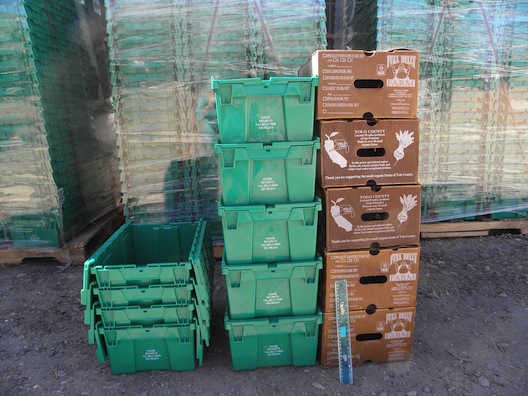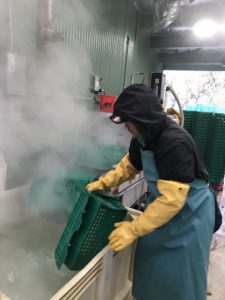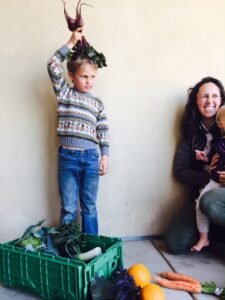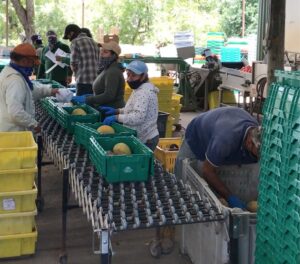
This week marks a CSA milestone: ten years ago, we stopped using waxed cardboard boxes for the CSA and started using the green plastic “Stop Waste” boxes*. We call them our “Stop Waste” boxes because the initial box purchase was aided by a grant from StopWaste. At the time of the switch, Judith wrote “this is a trial run” and since we’re still using them a decade later, it seems that the trial was a success. So this week, it’s a deep dive on boxes, accompanied by a smattering of vintage box photos from the past ten years.
We still use plenty of cardboard boxes (waxed and unwaxed). It’s a lot of packaging, but currently there isn’t a good system for using reusable boxes with most of our customers. We’re very conscious of all the packaging we have to use, and wish we didn’t need to, but it’s what makes sense when trying to optimize logistics, cost, food safety, and food quality. Plastic containers are expensive, it’s not feasible to get them back from most customers, and we don’t want to undo all of our hard work to produce the fruits and vegetables by using inadequate packaging that results in our customers getting subpar produce.
For all those reasons, cardboard boxes are still the norm for shipping produce from farms to wholesalers, stores, and restaurants, here and in the rest of the produce world. We use wax boxes for anything that might get wet; the wax helps the boxes stay strong even if damp. Wax boxes are currently accepted at most commercial compost facilities, but that wasn’t the case ten years ago, and even today, it’s unclear how many of these boxes end up getting composted. It’s reasonable to guess that many end up in the landfill. By switching the CSA boxes from waxed cardboard to reusable plastic, we’ve saved tens of thousands of boxes per year from potentially ending up in the landfill. The plastic boxes aren’t perfect, and all of us struggle a bit to view plastic as an environmental benefit. But in a world where waxed boxes can’t be recycled (and how much recycling actually is happening is up for debate) our current system of reusable boxes seems like a better option.
Like many decisions that we make here, making the change to the plastic boxes wasn’t a clear black and white choice and the tradeoffs had to be carefully considered. All the packaging decisions here are a tough balancing act between environmental sustainability, produce quality, durability, and price. Price is a factor to consider: each wax box is currently about $3 and the prices have gone up recently. The plastic boxes, while initially much pricer ($12.50/box when we got them in 2013), have been washed and reused so many times. We lose some boxes per year, and did make a second box order in 2017, but that’s nothing compared to how often we’d need to be ordering waxed cardboard, plus the cost and time it takes to fold those boxes.
Back in 2013, Judith ran a complicated analysis to compare box costs, based on several projections and predictions since we didn’t have experience yet with the new boxes. It’s not as simple as just comparing the price of the boxes, as the plastic boxes come with some additional costs, including:
- The plastic boxes weigh more, adding to freight costs and some human wear and tear.
- We can’t fit as many of the plastic boxes on a pallet as waxed boxes, again adding to freight costs over time.
- It’s great that we can wash and reuse the plastic boxes over and over again, but there is a cost to washing them (staff time, the cost to pump water to the box washer, extra wear and tear on the machine which we also use to wash produce) and in low-water years, that’s a lot of water.
After ten years, Judith’s financial guesstimate is “it’s a wash in terms of the financial costs, but clearly a huge gain in terms of the landfill and environmental costs.” When talking to Paul, Jan, and others about the switch to the boxes and their thoughts, there’s always a mention of the tradeoffs and difficulties of the reusable boxes, but a firm commitment to using them and an overall feeling that it’s the right thing to be doing.
10 year wedding anniversaries are traditionally commemorated with tin or aluminum, but in our case, any and all box-iversaries are probably best celebrated with a plastic box, grey or green. They aren’t supposed to leave the CSA sites, but if any have accidentally ended up at your home, bringing them back to your CSA site would be a great gift to commemorate this special occasion.
– Elaine Swiedler, CSA Manager
*we are currently using cardboard boxes for home delivery, a change that we made during the early days of the pandemic. We’re evaluating switching back but that’s TBD.



